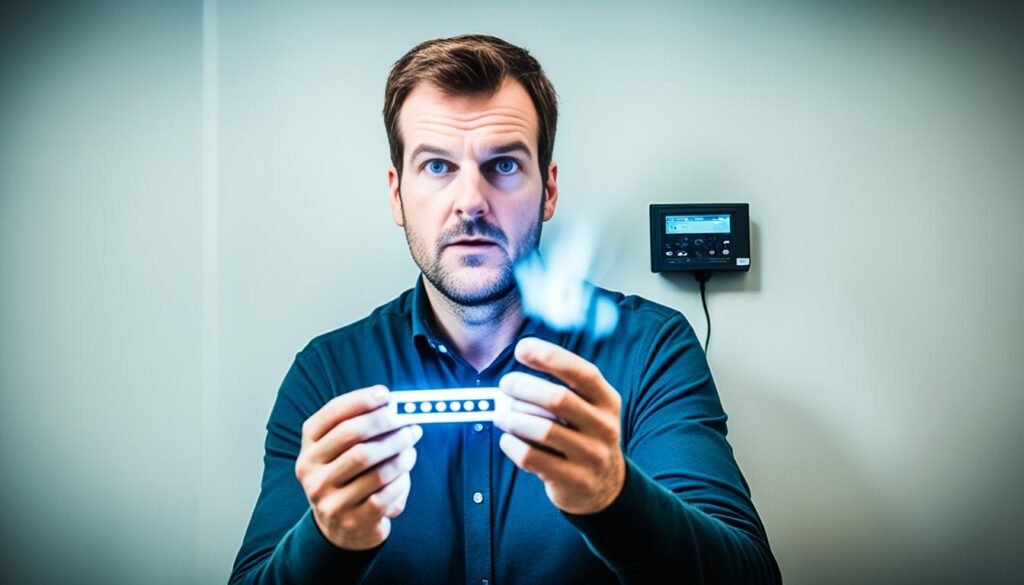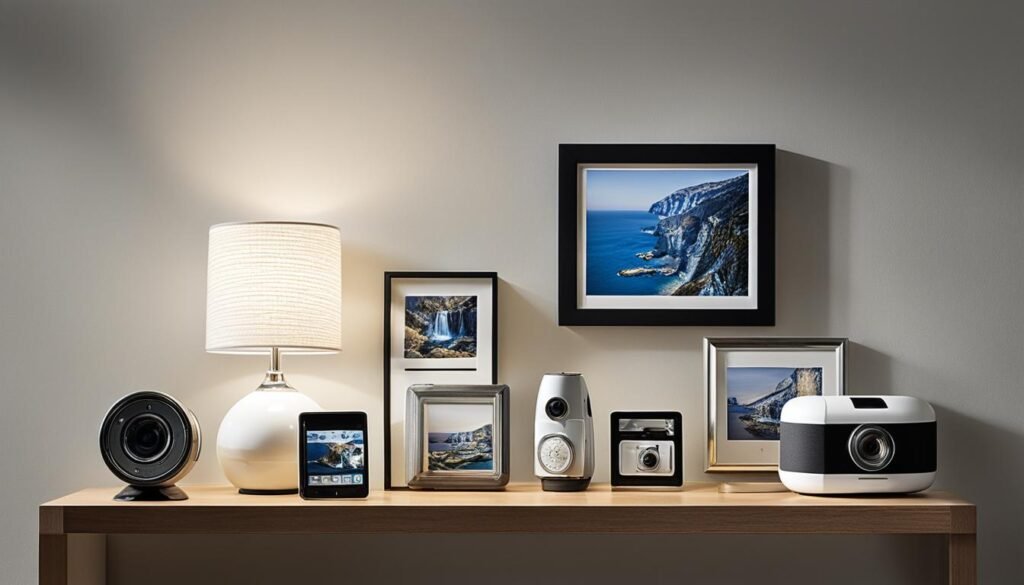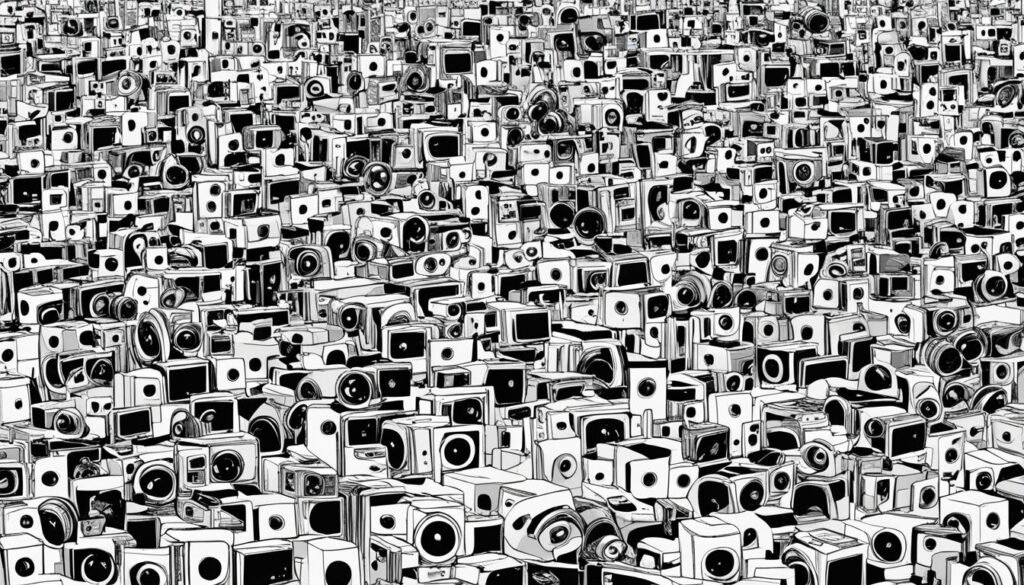Ever thought about how safe your private areas are from hidden cameras and microphones? In today’s world, hidden surveillance devices are getting smarter. That’s why finding these bugs is more important than ever. Bug detectors help keep your privacy safe and protect important business info.
There are many bug detectors out there, from simple ones costing $49.99 to complex systems worth $3,245.99. Each one has special features for different needs. They can find hidden cameras and audio bugs by detecting signals from 10kHz to 12GHz.
The “Ultimate RF Detection Suite” is a top choice with its wide range of 40 kHz to 6000 MHz. It offers strong protection against many spying threats.
When picking a bug detector, consider the SpyFinder Pro for spotting hidden cameras up to 45 feet away. Or the Black Ops RF Detection Probe for its 25-hour battery life. Some detectors even come with white noise generators to block audio bugs.
This guide will explain how these devices work and why they’re crucial for keeping your privacy safe. We’ll also help you find the best one for your needs. Are you ready to learn about bug detectors and protect your privacy?
Understanding Bug Detectors and How They Work
In today’s world, we’re more worried about our privacy. That’s why advanced bug detection tools are getting popular. These tools help find hidden cameras, audio bugs, and GPS trackers. They make sure our privacy stays safe.
The tech behind bug detection is complex. It’s important to know how each type works.
RF Detection Technology
RF detection technology is key in bug detectors. These tools scan for signals in the 1 MHz to 6 GHz range. They find hidden audio bugs and GPS trackers.
Tools like the RF Wireless Signal Detector Wand can spot and block these threats. They’re vital for surveillance countermeasures.
Camera Detection Mechanisms
Camera detectors find hidden cameras, like those disguised as smoke detectors or PIR alarms. They use a visual method to spot cameras. A ring of LEDs and a special lens make camera lenses look like bright red dots.
Some detectors look for small lenses, while others can see up to 25 feet wide. With more hidden cameras being found, these tools are key in bug sweeping operations.
Magnetic Field Scanning
Magnetic scanners help find hidden GPS trackers, especially in cars. They detect magnetic fields to spot GPS devices. These scanners are important but have limits.
They work best with other detection methods. Still, using magnetic field scanning in surveillance countermeasures helps find threats.
Together, RF detection, camera detectors, and magnetic scanners offer strong ways to protect against hidden surveillance. They’re crucial for keeping our privacy safe, in both our homes and work.
Top Bug Detectors on the Market
Today, there are many bug detectors available, making it key to know which ones are the best. We’ll look at some top-rated bug detectors that are popular:
The Delta X Portable Professional Bug Detection system is a top choice, costing $19,990.00. It can detect signals from 1 MHz to 13 GHz and lasts up to 25 hours on a battery. It’s perfect for professionals who need detailed surveillance detection.
For those on a budget, the deScammer™ Credit Card Skimmer Detector is the cheapest at $49.99. It’s great for checking personal spaces like hotel rooms for hidden threats.
Looking for something in the middle? Brands like Lawmate™ and Defender offer reliable options. Prices range from $155.00 to $1,429.99. These models have features like camera lens finders and can detect various signals, making them a good value.
The Sherry K68 is seen as the best bug detector overall. It’s known for its effectiveness and popularity. The G6 Sport is great for travelers because it’s portable and easy to use. The Jepwco G4 Pro is compact but powerful. The Latnex SPA-6G shows signals visually, which is great for tech-savvy users. The JMDHKK M8000 and DefCon DD1206 are versatile, fighting against industrial espionage.
With 28 bug detectors available, there’s a wide range of options. Whether you need a simple DIY model or a professional device, there’s something for you. With 11% of travelers facing hidden cameras, reliable bug detectors are a must.
Why You Need a Bug Detector
Today, keeping your privacy safe is more important than ever. With the rise of small, affordable spy tech, both people and businesses face threats from hidden eavesdropping devices. This makes it crucial to have reliable bug detectors.
Protecting Personal Privacy
Many see protecting their privacy as a key concern. The demand for bug sweeps and ways to fight back against hidden cameras and bugs has grown. Bug detectors are a useful tool to find and stop these threats. They let people check their homes, hotel rooms, and cars for hidden bugs. This gives people peace of mind, especially when traveling, and keeps their personal spaces safe.
Securing Business Assets
Businesses also have big reasons to use bug detectors. Stopping espionage is key to keeping company secrets safe and staying ahead in the market. Hidden bugs can lead to big financial losses and harm business security. Bug detectors spot audio bugs, cameras, and devices that send out signals, which could be used to steal company info.
Regular checks with these tools make sure employees’ and clients’ secrets stay safe. Doing bug sweeps after strange events or unauthorized entry is a smart way to prevent espionage.
Types of Hidden Surveillance Devices
Learning about hidden surveillance devices helps in using bug detectors well. It makes finding these devices easier and more accurate. With more hidden cameras, audio bugs, and tracking devices around, staying informed and safe is key.
Hidden Cameras
Hidden cameras are small and blend into everyday items like smoke detectors, clocks, or phone chargers. They can record video and send it wirelessly. To find these, use bug detectors that look for their radio signals. With their rise in places like hotels and rentals, having a camera detector is a must.
Wireless Audio Bugs
Covert audio devices, or wireless audio bugs, capture and send out audio. They can be hidden in things like pens or power strips. These devices send out radio or audio signals that bug detectors can pick up. They’re often used for spying and can affect personal and business talks.
GPS Trackers
GPS trackers keep tabs on cars or people’s locations. They can be hidden in cars, backpacks, or other items. These trackers send out signals that bug detectors can detect by their unique frequency. Making sure your car is free from these trackers keeps your privacy and security safe.
Knowing about these hidden devices helps people use bug detectors to keep their spaces safe from unwanted monitoring. This leads to more peace of mind and privacy.
Choosing the Right Bug Detector for Your Needs
When picking bug detectors, both people and companies must be thorough. This ensures the best protection against hidden surveillance. Here are some tips to help you:
- Budget Considerations: Bug detectors can cost from under $100 to about $10,000. Models over $400 are often handcrafted or tested for better performance. Spending more can get you a device with stronger filters, protecting against ambient signals and reducing false alarms.
- Coverage Frequency: A good bug detector should scan from 1MHz to 6GHz. This range covers many risks. For serious threats, choose one with wider coverage.
- Additional Features: Look for detectors with extra features. These include audio plugs for listening in, silent mode with vibration alerts, signal strength graphs, and strong metal bodies.
- Types of Surveillance Devices: The detector should find various devices like RF transmitters, GSM bugs, Wi-Fi bugs, and hidden cameras. Self-recording bugs are small and need charging, so they’re harder to find.
- Detection Accuracy: Using sweep techniques in both directions improves accuracy. Start by sweeping the area and checking for signals before turning off the power. This helps spot any suspicious signals.
With more devices for eavesdropping available, doing thorough bug sweeps is crucial. It’s not just for personal use but also for protecting telecommunication systems. Private investigators suggest using advanced bug detectors for thorough checks. Whether for a home or business, the right detector can greatly improve your security.
How to Use a Bug Detector Effectively

Bug detectors are high-tech tools that find hidden surveillance gadgets. They’re key for keeping your privacy safe at home, work, or while traveling. To use them well, you need to know the steps and avoid mistakes.
Step-by-Step Instructions
An instruction guide for bug detectors makes sweeping easier and more accurate. Here are the main steps:
- Prepare Your Equipment: Make sure your bug detector is charged and ready. Using different detectors can help find more bugs.
- Scan the Area: Slowly move the detector over surfaces, focusing on places bugs might hide. Check near electronics and power sources carefully.
- Utilize Multiple Detection Modes: Try different modes on your detector to catch various bugs.
- Stay Inconspicuous: Be careful not to draw attention in places where bugs might be hidden.
- Verify Suspicious Signals: If your detector finds something, check it again with other methods to make sure it’s real.
Common Mistakes to Avoid
When sweeping for bugs, it’s easy to make mistakes. Here’s how to avoid them:
- Moving Too Quickly: Don’t rush your scan. Go slow to catch everything.
- Overlooking Small Hiding Places: Bugs can hide in tiny spots. Check everywhere, even in small places.
- Ignoring Environmental Interference: Some signals might not be bugs. Know what’s normal in your area.
- Underestimating the Need for Frequent Checks: Sweep regularly to keep your privacy safe. New bugs can show up anytime.
Follow these tips to improve your bug sweeping skills. Using an instruction guide for bug detectors and knowing common mistakes helps keep you safe.
Key Features to Look for in Bug Detectors
When looking for a bug detector, it’s key to check how well it finds hidden surveillance devices. These features ensure you pick the right tool for your needs.
Scanning Range
The scanning range of a bug detector is very important. Good ones can detect a wide range of frequencies, from low MHz to high GHz. This means they can find many types of devices.
Top models scan across different bands like GSM, CDMA, 3G, 4G, Wi-Fi, and Bluetooth. This makes them very effective.
Portability
Portable bug sweepers are great because they’re easy to carry around. You can quickly check for bugs in places like hotel rooms, offices, or homes. They’re small, light, but still tough and work well.
Alert Mechanisms
How a bug detector alerts you is crucial. Modern ones give you real-time alerts through sounds, lights, or on your phone. Some even analyze signals to tell you if they’re from a spy device or not. This makes them much more accurate.
In the end, looking at the scanning range, how easy it is to carry, and the alerts it gives can help you find the best bug detector for your needs.
Bug Detectors vs. Software Testing Tools
Bug detectors and software testing tools serve different purposes. Bug detectors find hidden cameras and audio bugs. Software testing tools look for bugs in digital systems.
Code Analysis Tools
Code analysis tools are key in software testing. They check code for issues that could cause problems. Static analysis tools look at code without running it, finding errors and security risks early.
Dynamic analysis tools watch how code acts when it runs. They find issues like slow performance and memory problems.
Static vs. Dynamic Analysis
Static and dynamic analysis have their own roles in testing software. Static analysis tools like Coverity and SonarQube check code before it runs. They find many bugs early.
But, they might miss bugs that show up when the software runs. Dynamic analysis tools run the program to see how it behaves. Tools like Valgrind and IBM’s Rational Purify find bugs static analysis misses.
Using different tools and techniques helps catch more bugs. This way, software can be made more reliable and efficient. It covers all kinds of issues, from code problems to runtime errors.
Real-world Applications of Bug Detectors
Bug detectors are key in many situations where privacy and security matter a lot. They are often used in hotel rooms and to check for GPS trackers in vehicles. These uses show how useful and effective they are.
Hotel Room Inspections
Travelers worry about hotel room security. It’s important to make sure there are no hidden cameras or bugs. Bug detectors help find and remove these threats.
They scan for RF signals, which are key in spotting hidden bugs. These signals range from 3 kHz to 300 GHz. So, they catch the signals from hidden cameras or audio bugs.
When checking hotel rooms, bug detectors look in places like smoke detectors and electrical outlets. These spots are where bugs might be hidden.
Vehicle Scans for GPS Trackers
Security is also a big deal for cars. Finding GPS trackers in vehicles is a common use of bug detectors. These devices look for GPS signals in certain frequencies, like 824-846 MHz and 880-920 MHz.
This is important for people who don’t want their movements tracked. It’s also key for those in jobs where privacy is crucial. High-end bug detectors are great for these situations, offering top-notch features to find and block trackers.
In summary, bug detectors are crucial for keeping hotel rooms and vehicles safe from bugs and GPS trackers. Using them helps people protect their privacy and security in different situations.
Cost and Value of High-Quality Bug Detectors
Buying a top-notch bug detector is a smart move, especially with all the surveillance around us. The Professional RF Bug Detector from KJB Security is a great example. It measures 4.21″ x 2.25″ x 1″ and costs about $350. This device can detect signals from 10MHz to 10GHz, covering GSM, GPS, LTE, Wi-Fi, Bluetooth, and RF signals.
This bug detector offers more than just detection. It also has a white noise generator, light meter, and lens finder attachment. Since 2017, many customers have praised its reliability and effectiveness. It’s made of durable aluminum alloy and uses replaceable 9v batteries, making it a long-lasting choice.
Having a good bug detector means you can rest easy, knowing you’re protected. The KJB Security RF Bug Detector stands out with its 16-segment bar graph indicator and dual antenna setup. It can find a variety of signals, from VHF/UHF to LTE, offering deep protection. Investing in quality means better detection and more security, showing the bug detector’s true value.


